Abstract
The prevalence of known cases of acromegaly in Northern Ireland in 1984 was 6.3 per 100,000 population. The incidence of newly-diagnosed cases over the preceding 25 years was 5.5 patients per year, or 0.4 patients per 100,000 population per year. This rate would be equivalent to about 200 new cases per year in the United Kingdom. Four options have been available to most of these patients--surgical hypophysectomy (transfrontal or transsphenoidal), pituitary radiotherapy (usually external cobalt beam), drug treatment with bromocriptine, or no treatment. Choice of treatment has been mainly influenced by tumour size, with the larger pituitary adenomas having surgery initially. No single form of treatment has been successful in achieving a clinical remission or cure in more than a minority of cases. The most successful outcome has been where total pituitary ablation has been achieved. Life-table analysis for the whole group shows life expectancy which is not markedly different for that of an age-matched population from Northern Ireland. Morbidity related to long term osteoarthritis and treatment complications remain a major problem. The incidence of malignant tumours is higher than would be expected.
Full text
PDF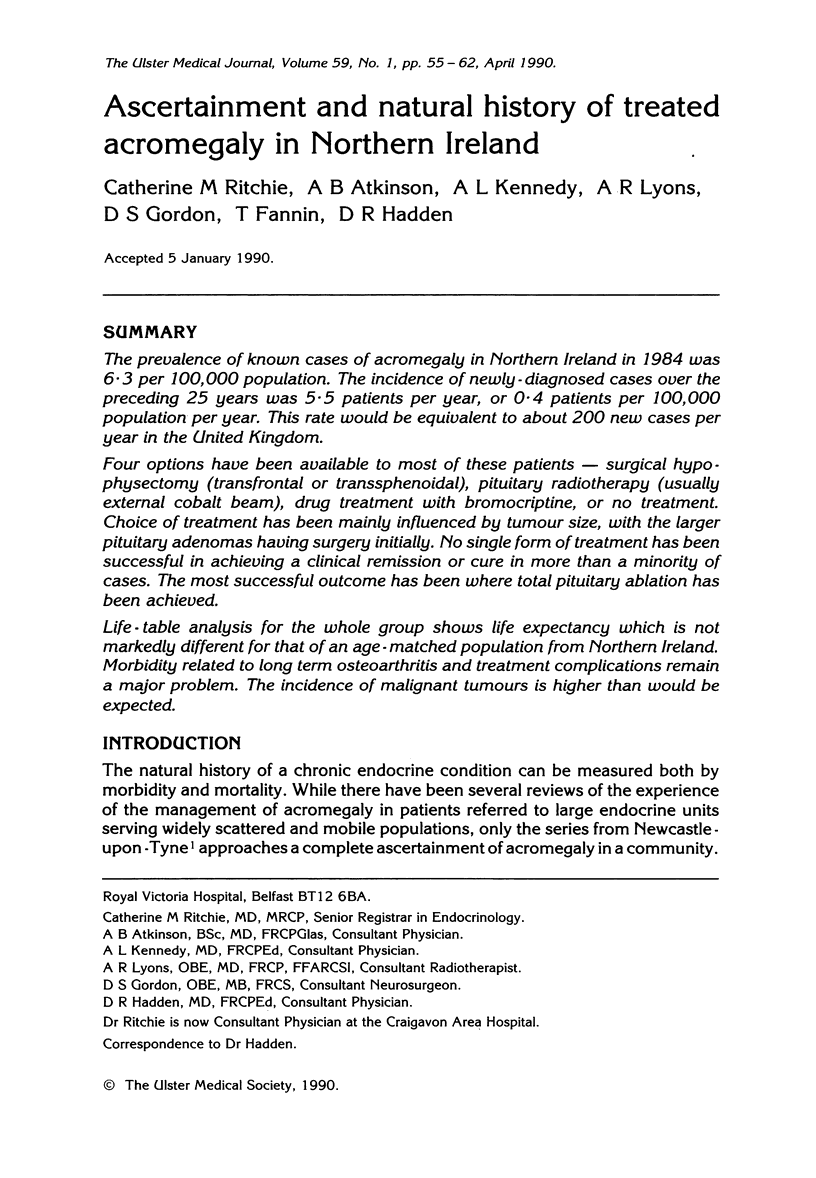
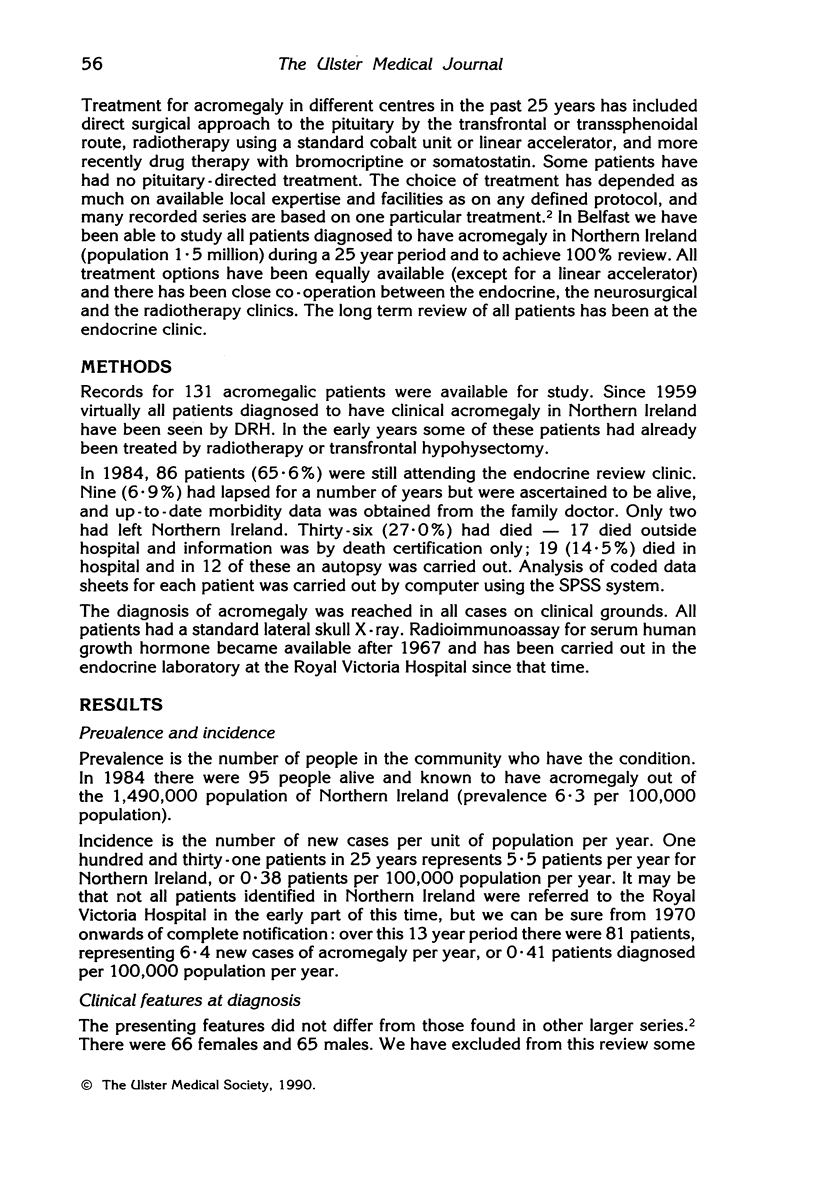
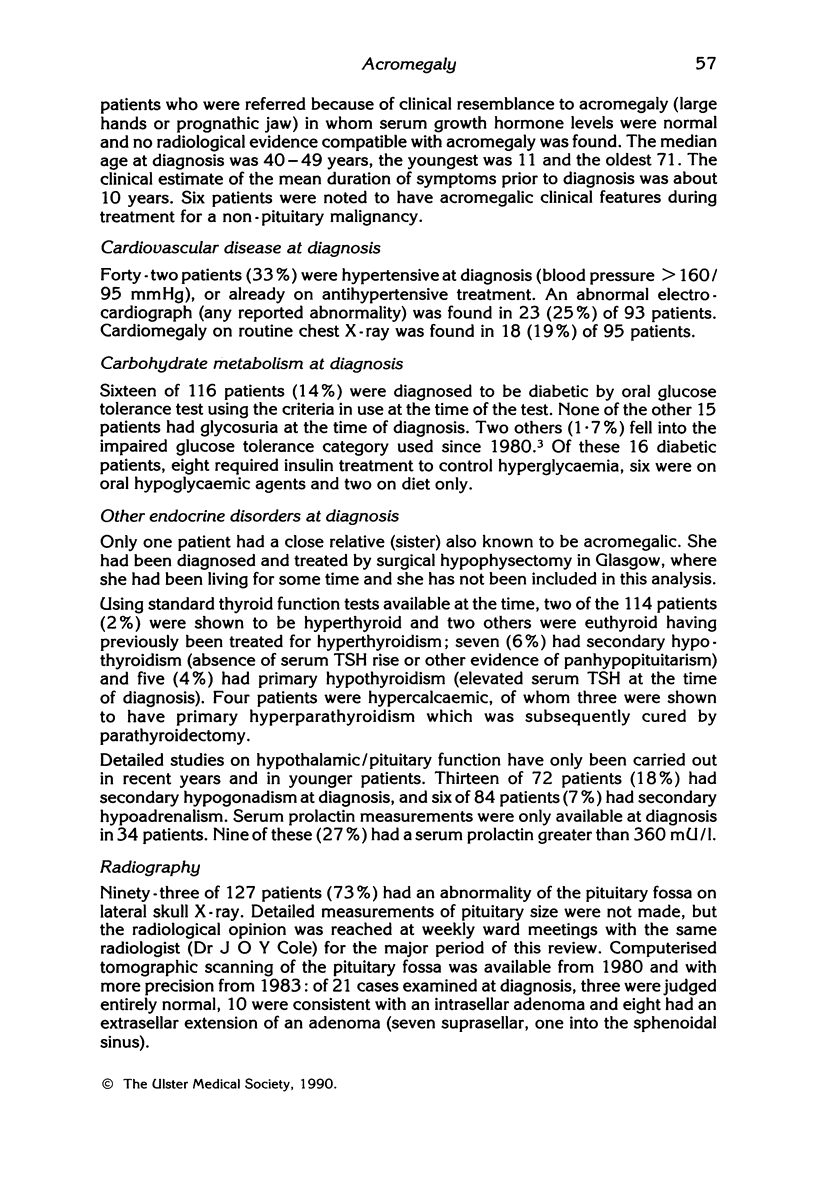
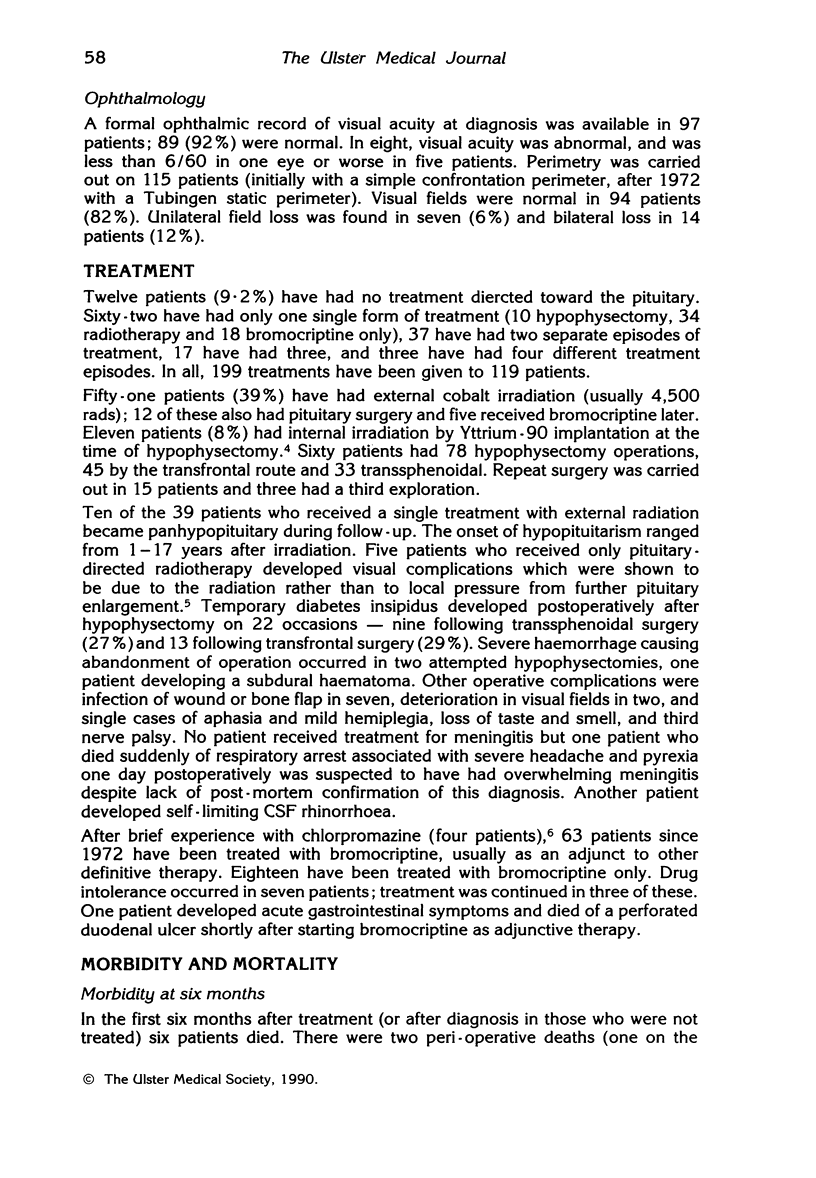
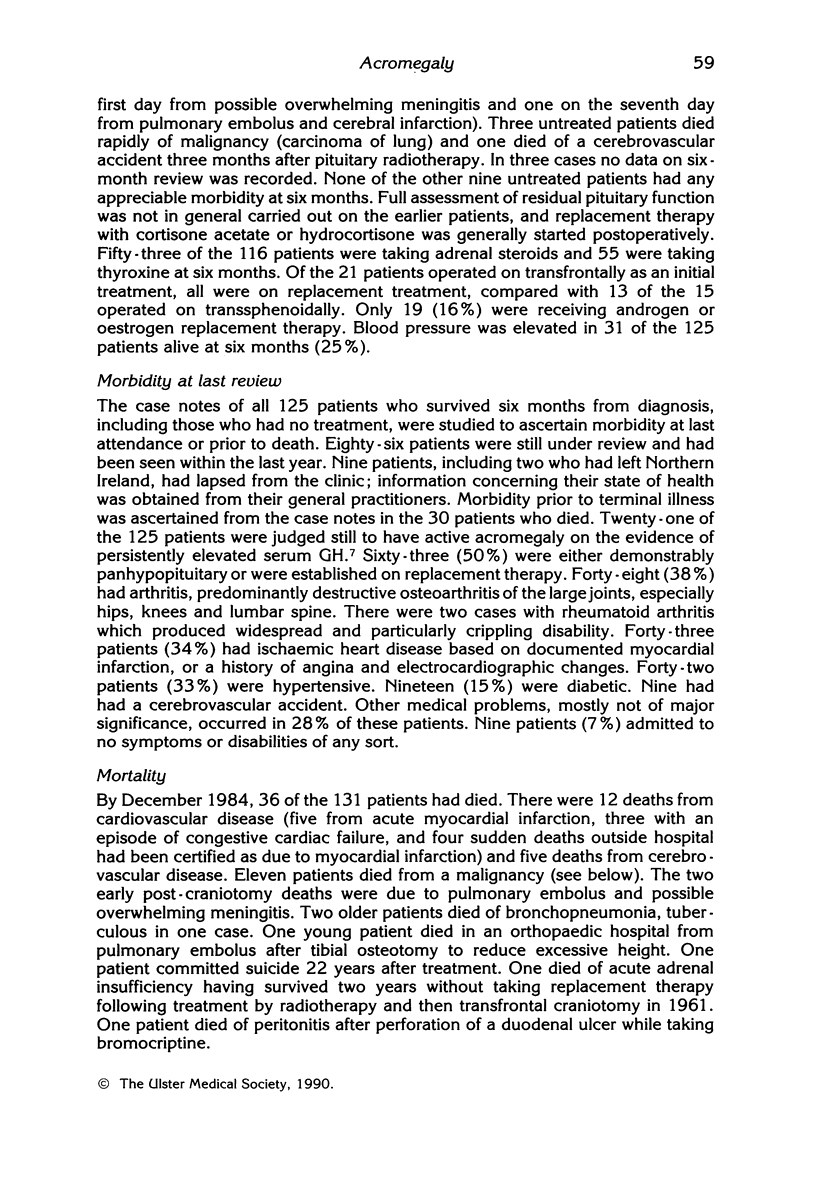

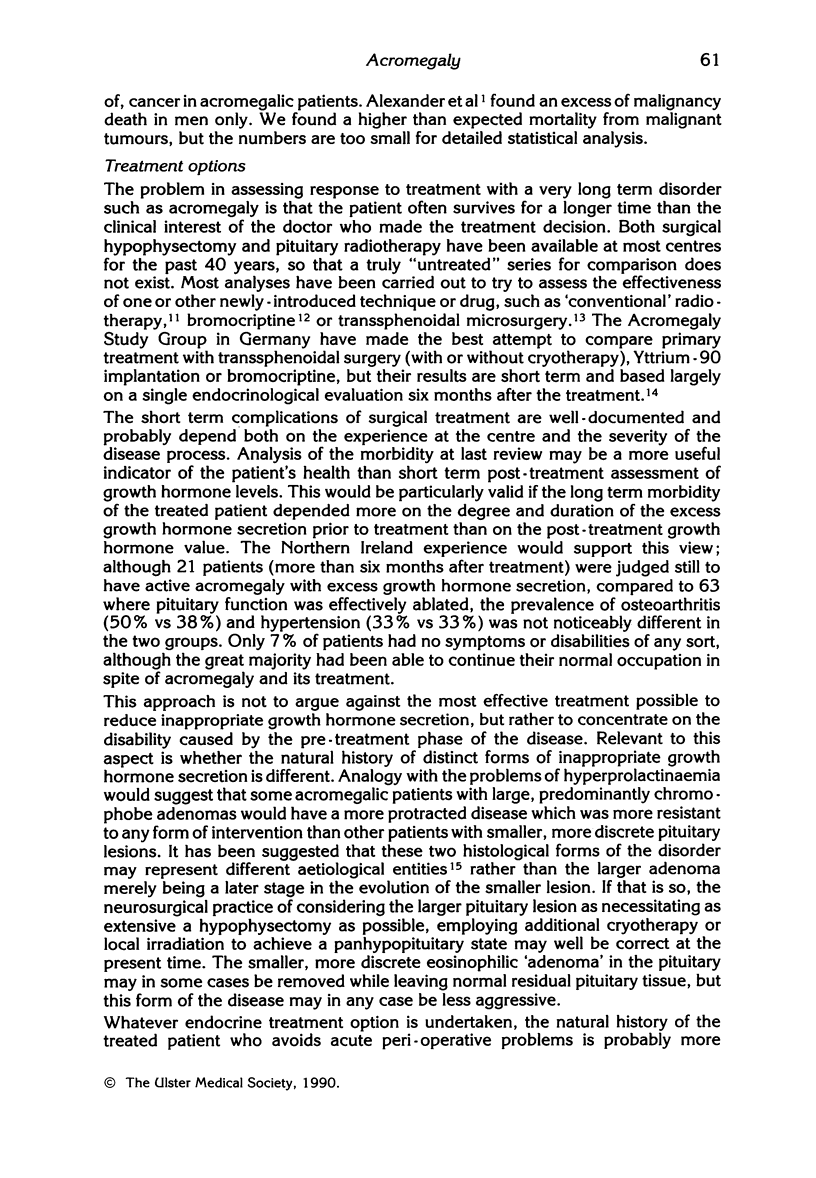

Selected References
These references are in PubMed. This may not be the complete list of references from this article.
- Alexander L., Appleton D., Hall R., Ross W. M., Wilkinson R. Epidemiology of acromegaly in the Newcastle region. Clin Endocrinol (Oxf) 1980 Jan;12(1):71–79. doi: 10.1111/j.1365-2265.1980.tb03135.x. [DOI] [PubMed] [Google Scholar]
- Atkinson A. B., Allen I. V., Gordon D. S., Hadden D. R., Maguire C. J., Trimble E. R., Lyons A. R. Progressive visual failure in acromegaly following external pituitary irradiation. Clin Endocrinol (Oxf) 1979 May;10(5):469–479. doi: 10.1111/j.1365-2265.1979.tb02103.x. [DOI] [PubMed] [Google Scholar]
- Bell P. M., Atkinson A. B., Hadden D. R., Kennedy L., Leslie H., Merrett J. D., Sheridan B. Bromocriptine reduces growth hormone in acromegaly. Arch Intern Med. 1986 Jun;146(6):1145–1149. [PubMed] [Google Scholar]
- EDELSTYN G. A., GLEADHILL C. A., LYONS A. R., RODGERS H. W., TAYLOR A. R., WELBOURN R. B. Hypophysectomy combined with intrasellar irradiation with yttrium-90. Lancet. 1958 Mar 1;1(7018):462–463. doi: 10.1016/s0140-6736(58)90767-0. [DOI] [PubMed] [Google Scholar]
- Eastman R. C., Gorden P., Roth J. Conventional supervoltage irradiation is an effective treatment for acromegaly. J Clin Endocrinol Metab. 1979 Jun;48(6):931–940. doi: 10.1210/jcem-48-6-931. [DOI] [PubMed] [Google Scholar]
- Ituarte E. A., Petrini J., Hershman J. M. Acromegaly and colon cancer. Ann Intern Med. 1984 Nov;101(5):627–628. doi: 10.7326/0003-4819-101-5-627. [DOI] [PubMed] [Google Scholar]
- Jadresic A., Banks L. M., Child D. F., Diamant L., Doyle F. H., Fraser T. R., Joplin G. F. The acromegaly syndrome. Relation between clinical features, growth hormone values and radiological characteristics of the pituitary tumours. Q J Med. 1982 Spring;51(202):189–204. [PubMed] [Google Scholar]
- Lindholm J., Giwercman B., Giwercman A., Astrup J., Bjerre P., Skakkebaek N. E. Investigation of the criteria for assessing the outcome of treatment in acromegaly. Clin Endocrinol (Oxf) 1987 Nov;27(5):553–562. doi: 10.1111/j.1365-2265.1987.tb01185.x. [DOI] [PubMed] [Google Scholar]
- MUSTACCHI P., SHIMKIN M. B. Occurrence of cancer in acromegaly and in hypopituitarism. Cancer. 1957 Jan-Feb;10(1):100–104. doi: 10.1002/1097-0142(195701/02)10:1<100::aid-cncr2820100113>3.0.co;2-v. [DOI] [PubMed] [Google Scholar]
- Quabbe H. J. Treatment of acromegaly by trans-sphenoidal operation, 90-yttrium implantation and bromocriptine: results in 230 patients. Clin Endocrinol (Oxf) 1982 Feb;16(2):107–119. doi: 10.1111/j.1365-2265.1982.tb03154.x. [DOI] [PubMed] [Google Scholar]
- Roelfsema F., van Dulken H., Frölich M. Long-term results of transsphenoidal pituitary microsurgery in 60 acromegalic patients. Clin Endocrinol (Oxf) 1985 Nov;23(5):555–565. doi: 10.1111/j.1365-2265.1985.tb01116.x. [DOI] [PubMed] [Google Scholar]
- Singh P., McDevitt D. G., Mackay J., Hadden D. R. Effects of L-dopa and chlorpromazine on human growth hormone and TSH secretion in normal subjects and acromegalics. Horm Res. 1973;4(5):293–301. doi: 10.1159/000178316. [DOI] [PubMed] [Google Scholar]
- Wright A. D., Hill D. M., Lowy C., Fraser T. R. Mortality in acromegaly. Q J Med. 1970 Jan;39(153):1–16. [PubMed] [Google Scholar]


